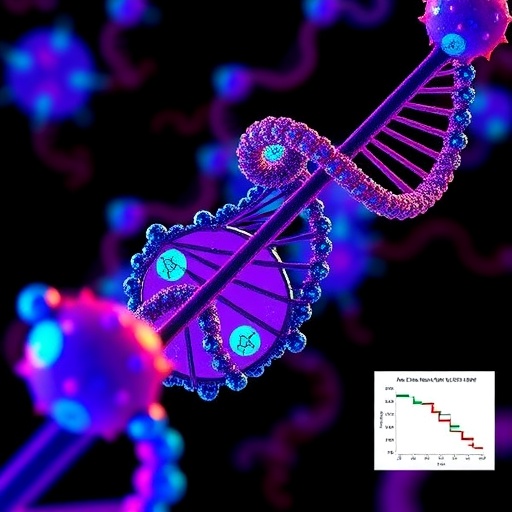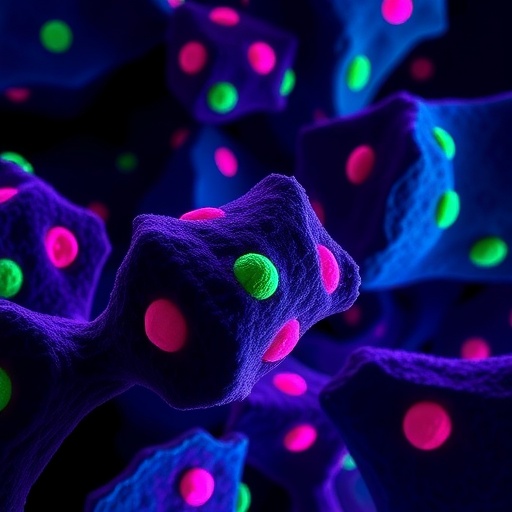
In recent advancements within the realm of hematologic malignancies, researchers have shed new light on the intricate regulatory disruptions driving acute myeloid leukemia (AML) development and relapse. AML, a highly aggressive blood cancer characterized by the abnormal proliferation of myeloid precursor cells, remains a formidable clinical challenge largely due to its genetic complexity and frequent relapse after treatment. The latest study integrates cutting-edge single-cell technologies to unravel the chromatin and transcriptional irregularities underpinning AML pathogenesis, offering unprecedented insight into disease mechanisms and potential prognostic markers.
Central to this investigation is the application of mitochondrial single-cell assay for transposase-accessible chromatin sequencing (mtscATAC-seq), coupled with single-cell RNA sequencing (scRNA-seq). This innovative dual-omics approach enables simultaneous exploration of chromatin accessibility landscapes and transcriptional profiles within thousands of individual AML cells. By constructing a comprehensive hematopoietic reference atlas, the researchers successfully mapped AML cells onto normal hematopoietic differentiation trajectories, thereby pinpointing aberrant cis-regulatory elements (CREs) and transcription factor networks perturbed in leukemia.
A salient discovery involves mutations in the WT1 gene, a critical transcription factor in hematopoietic regulation and tumor suppression. Specifically, mutations clustered within WT1’s zinc finger DNA-binding domain were correlated with marked decreases in chromatin accessibility at target regulatory regions. This closed chromatin state coincided with hypermethylation, a well-known epigenetic silencing mechanism, leading to transcriptional repression of genes essential for normal differentiation. Experimental validations affirmed that five distinct WT1 zinc finger variants exert strong pathogenic effects by disrupting normal gene regulatory circuits, thereby promoting AML pathogenesis.
.adsslot_moYVgwZ9cn{width:728px !important;height:90px !important;}
@media(max-width:1199px){ .adsslot_moYVgwZ9cn{width:468px !important;height:60px !important;}
}
@media(max-width:767px){ .adsslot_moYVgwZ9cn{width:320px !important;height:50px !important;}
}
ADVERTISEMENT
Beyond transcription factor mutations, the study explored mutations residing directly within CREs themselves. One noteworthy mutation introduced a novel DNA binding motif for the CEBPB transcription factor within enhancer regions. This novel motif facilitated enhanced CEBPB binding, which in turn elevated enhancer activity and downstream gene expression. These molecular alterations effectively accelerated AML cell proliferation and survival, unveiling a previously underappreciated mechanism by which non-coding mutations can drive malignancy. Functional assays, including luciferase reporter assays and prime editing technologies, confirmed the causative role of this enhancer mutation.
Delving deeper into AML’s clonal architecture and relapse dynamics, the study employed mitochondrial DNA (mtDNA) lineage tracing combined with machine learning models. This innovative approach enabled the precise identification of relapse-associated leukemic clones that bear molecular signatures overlapping with leukemia stem cells (LSCs), which are believed to be reservoirs of therapy resistance. Marker genes derived from these clones demonstrated superior predictive accuracy for drug resistance and relapse risk compared to traditional biomarkers, underscoring their clinical significance.
The integration of mtDNA mutation data with chromatin accessibility and transcriptomic profiling facilitated a holistic view of AML evolution, linking genetic alterations, epigenetic regulation, and functional outcomes at the single-cell level. This multidimensional insight not only elucidates mechanisms of disease progression but also highlights potential targets for therapeutic intervention, particularly in the context of preventing relapse. By tracing relapse-prone clones and characterizing their regulatory networks, the research paves the way for precision medicine approaches tailored to AML’s heterogeneity.
Such comprehensive single-cell analyses reveal that transcriptional dysregulation in AML is multifaceted, involving both direct mutations in transcription factors and indirect modulation via mutated regulatory DNA elements. The WT1 mutations exemplify how loss of transcription factor function can remodel the epigenomic landscape towards a repressed state, while the CRE mutation introduces a gain-of-function mechanism enhancing oncogenic transcriptional programs. Together, these insights expand our understanding of how genetic changes converge on chromatin architecture to derail hematopoietic differentiation and fuel malignancy.
This study’s innovative methodology underscores the power of combining high-resolution epigenomic assays with lineage tracing and computational modeling to dissect complex cancer biology. The use of mtscATAC-seq not only elucidates chromatin accessibility at unparalleled resolution but, when paired with mtDNA lineage information, allows temporal and spatial tracking of clonal evolution. Such an integrative framework is vital for deciphering the cellular hierarchies and molecular perturbations that underpin AML initiation, progression, and recurrence.
Importantly, the identification of relapse-related clones sharing features with LSCs has profound implications for clinical management. Targeting these clones could effectively mitigate relapse, which remains a major cause of treatment failure and mortality in AML patients. The molecular markers characterized in these clones offer promising avenues for the development of diagnostic assays to monitor minimal residual disease and to stratify patients based on relapse risk, enabling earlier and more tailored therapeutic interventions.
The study also highlights the expanding role of transcription factors beyond their canonical functions, illustrating how mutations can alter their DNA binding specificity and regulatory networks. By revealing how mutations in both protein-coding and non-coding regions synergistically contribute to AML pathology, the research challenges conventional paradigms and suggests that comprehensive genomic and epigenomic profiling will be indispensable in future AML research and clinical trials.
Collectively, these findings represent a technical and conceptual breakthrough in our understanding of AML biology. By harnessing advanced single-cell technologies, mitochondrial lineage tracing, and sophisticated computational modeling, the study uncovers the multilayered regulatory aberrations that drive AML and sustain relapse-prone subpopulations. This integrative approach sets a new standard for dissecting cancer heterogeneity and paves the way for novel prognostic tools and targeted therapies that may improve patient outcomes.
In summary, the intricate interplay between transcription factor mutations, mutated cis-regulatory elements, and epigenetic modifications orchestrates the aberrant gene expression programs underlying AML development and relapse. The fusion of mtscATAC-seq, lineage tracing, and transcriptomic analysis offers an unprecedented lens into this pathology, enabling the identification of critical regulatory nodes and relapse-associated clones. These insights provide a foundation for future research aimed at precision targeting of AML’s clonal diversity and therapeutic resistance, heralding a transformative era in leukemia treatment.
As AML remains a challenging malignancy with high relapse rates, studies like this, which dissect the molecular basis of disease progression at the single-cell level, are pivotal. They not only enhance our fundamental understanding of leukemogenesis but also inform the development of next-generation diagnostics and therapeutics. Ultimately, such integrative, mechanistic investigations promise to shift the treatment paradigm towards more effective and relapse-resistant strategies in acute myeloid leukemia.
Subject of Research: Acute Myeloid Leukemia (AML) regulatory aberrations and clonal relapse dynamics
Article Title: Integrative scATAC-seq and mtDNA mutation analysis reveals disease-driven regulatory aberrations in AML
News Publication Date: Not provided
Web References: http://dx.doi.org/10.1016/j.scib.2025.07.009
References: Not explicitly provided
Image Credits: ©Science China Press
Keywords: Acute myeloid leukemia, transcription factor mutations, WT1, cis-regulatory elements, chromatin accessibility, mtscATAC-seq, single-cell RNA sequencing, mitochondrial DNA lineage tracing, leukemia stem cells, enhancer mutation, CEBPB, relapse biomarkers, epigenetic regulation
Tags: acute myeloid leukemia researchchromatin accessibility in leukemiadual-omics approach in cancerhematologic malignancies advancementshematopoietic differentiation trajectoriesmtDNA mutations in AMLprognostic markers in blood cancerregulatory disruptions in acute myeloid leukemiasingle-cell technologies in cancertranscription factor networks in AMLtranscriptional irregularities in AMLWT1 gene mutations and leukemia





